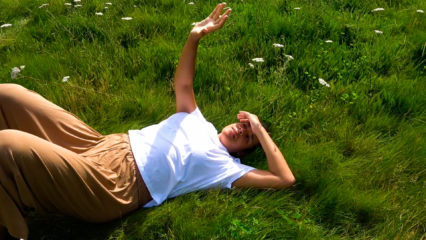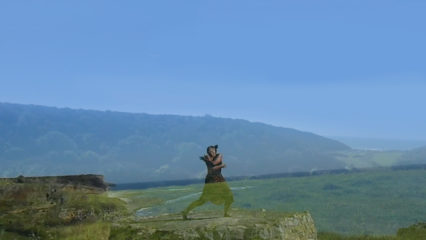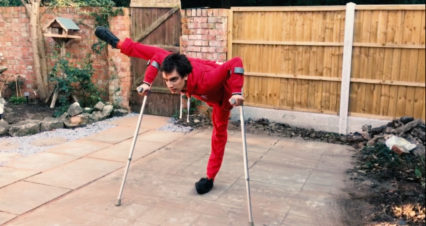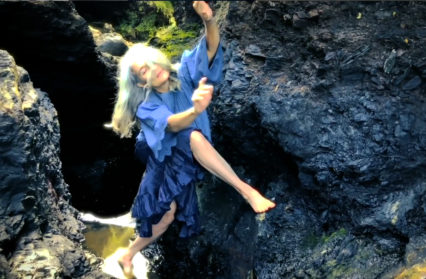Marine Furet reviews the final four performances of Plethu/Weave, a collaborative project between National Dance Company Wales and Literature Wales which sets unique dances to short poems.

‘I’m guilty of saying that ‘I don’t understand dance’ – guilty of assuming that the intention is to ‘understand’’. In a blog post written about the creative process at work behind her collaboration with dance artist Shakeera Ahmun, poet Elan Grug intuitively gets at the challenge raised by Plethu/Weave. Begun earlier this autumn, the project consists of eight short videos in which a dancer moves to the sound of a commissioned poem read by its author. These instalments seem to form an archive of words, movements, and images of contemporary Wales.
Of the last four videos, three are set outdoors and make the most of Welsh landscapes. The video accompanying Grug’s poem ‘Cyswllt|Datgywsllt’ (‘Attachment|Detachment’) situates its performer in a hybrid landscape of sea and city. Ahmun, the performer, edited the video herself. Shots of her contorting hands and wrists, her toes playing with the sand, her body running and tumbling down a dune and her bare feet on a wooden pier give rhythm and life to her video. When creating the piece, both Grug and Ahmun found themselves struggling with linguistic difficulties: Grug’s love of literacy in the language of dance is reflected in Ahmun’s inability to speak Welsh. Both artists, however, appear to have successfully translated their language to each other. Ahmun’s video is simple but creates a montage of breaks, images, and colours that follow their own logic without obstructing that of the text.

The perils in-betweenness transpires, by contrast, in ‘The Branches of Me’, a collaboration between writer Connor Allen and Jodi Ann Nicholson. Allen’s verse and Nicholson’s dance seem to spring from different sources. Allen’s poem has an air of slam and, at times, echoes the introspective anger of some well-known Black rappers’ flows (I couldn’t help but hear the sonorities of Kendrick Lamar’s ‘The Blacker the Berry’ in some lines of Allen’s). The urgency of the poem is underlined by a short extract of the video of George Floyd’s death, which gave fire and rage to thousands of #BlackLivesMatter protests across the US and the UK this summer. By contrast, Nicholson made the decision to dance on an empty space near a cliff path in a landscape that could be somewhere in green Pembrokeshire. Her movements are slow and deliberate, and we can hear the sound of the sea.
There is something incongruous in the superposition of body and words, here, perhaps intended to question our assumptions about who has a right of way in the Welsh landscapes. For me, this contrast sometimes resulted in cutting off the choreography from the text, and I found myself watching ‘The Branches of Me’ several times, paying attention to the voice, then to the video, but struggling to reconcile both. I also wondered at the echoes between the videos in the series: like Marvin Thompson and Ed Myhill’s creation ‘Triptych Part I’, ‘The Branches of Me’ also calls for uncomfortable superpositions of black bodies and the sea that hark back to transatlantic slavery.

‘O’r Lludw’ (‘From the Ashes’) shares the political impulse that animates a number of the videos. Choreographed and performed by disabled dancer Joe Powell-Main to the sound of Aneirin Karadog’s poem, the video was inspired by the disability advocacy campaign #weshallnotberemoved. It includes what seem to be webcam shot passages showing Powell-Main dancing in a wheelchair and increasingly acquiring greater freedom of movement until he exits his house. The poem similarly invites us to live in the present: ‘our dance is what we light in our now’. The production shares its optimistic outlook with the series’ last instalment ‘Swyn-gân/Summoning’, which is performed, choreographed and directed by Jo Shapland. Here video editing seems to become part of the dance itself. The Welsh landscape is turned into a series of shots, ingredients to be added to the ‘witch’s cauldron’ evoked by Clare e. potter’s poem. As Shapland’s movements allude to ‘the sea’s graffiti’, we are invited to enjoy a landscape where ‘the baptized words are brining’ and to honour the Welsh landscape’s ability to inspire.
To find out more about Plethu/Weave, visit National Dance Company Wales’ website.
Marine Furet is an avid contributor to Wales Arts Review.
(Header image: still from Swyn-gân/Summoning by Clare e. potter and Jo Shapland)












